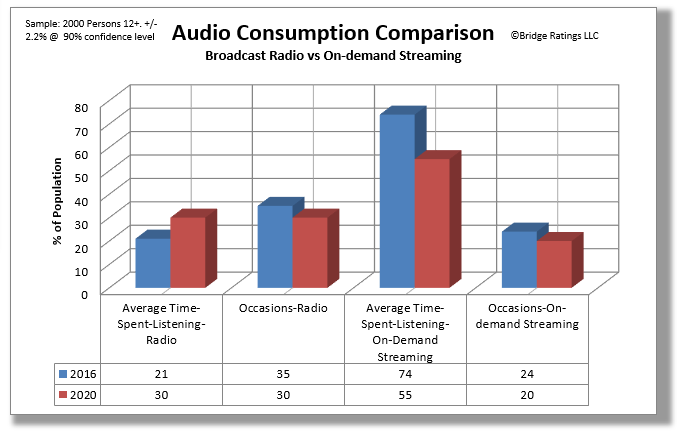Here's a little secret: Broadcast radio is benefiting from music streaming.
As has been shown in previous Bridge Ratings studies, broadcast radio (AM/FM) has sustained a barrage of technical competitors for share-of-mind since 2000: music file sharing, music downloads, internet radio, on-demand streaming.Through it all, radio has managed to remain a popular choice among all age groups though younger consumers are spending more time with their smartphones, tablets and computers at the expense of AM/FM radio.
Yet in this boiling mix of options for listeners of music, broadcast radio's value is rising.
The secret weapon: Curation.
As technology has improved access for all of us to enjoy music one thing is clear: consumers of recorded music are discovering that there is much to discover - and rediscover. This is a good thing. And radio is helping with curation.
Click on image to enlarge.
The latest Bridge Ratings study looks at broadcast listening behavior among those in the sample who also spend at least 30 minutes a day listening to on-demand music services such as Pandora or Spotify.
This year's study revealed that 84% of the panel listened to a music-based radio-station during the survey week; 71% listened to an on-demand service.
How to read: Among radio core listeners who spend at least 1 hour a day with radio, Average time spent and number of occasions with radio have increased as streaming usage has increased.
Click on image to enlarge
And time-spent-listening for radio is being impacted by time spent with on-demand music services.
Interestingly, the number of times or occasions of listening have increased for both sources of music consumption.
Why does the panel in this survey listen to music radio?
They listen for songs they know as well as to discover new songs or songs they were previously unaware of.
One of the benefits of music streaming for radio listeners is discovering newly released songs or older songs never-before heard.
Our study revealed that for every major radio format, a significant number of “fresh" songs are being consumed by radio listeners. This discovery factor brings one lifegroup of these streaming listeners back to radio frequently to hear more fresh songs. This is one reason we are seeing increased listening occasions from radio core listeners who also stream music weekly.
They listen for companionship, local information and for the curation of music that radio provides.
Radio program managers are more capable than ever to know which songs their city and listeners will be most inclined to want to hear. Even in today's competitive environment, radio programmers listen to as many of the new releases as they can and make judgments as to which are apropos for on-air exposure.
It is this curation of music that brings listeners back to radio; to hear the best of the best which are often added to personal music collections or on-demand streaming service accounts.
Click on image to enlarge.
And more listen to radio to discover new songs than did in 2018. For many “new”, undiscovered songs are catalogue (2 years or older) songs they’ve never heard before.
A similar pattern holds true for those that stream music on-line. They like to hear songs they know, but a higher percentage also like to discover new music.
And while time spent with broadcast radio has been eroded, those we sampled are finding a new utility for broadcast radio music stations: curation.
Radio does this better than anyone
With the increasing availability and access to the world's vast music collection comes the decision stress of what to listen to and when. It is not a bad problem to have.
Broadcast radio music stations are helping with the challenge of what to listen to as these consumers of both technologies (analog radio and digital music streams) are learning to appreciate radio's ability to select music worth hearing. While this has perhaps always been a facet of broadcast radio programmers, the necessity of wading through all music that is available is being eased by broadcast radio's curation and exposure.
A growing number of listeners finds their favorite radio station is an important part of their music streaming experience.
The trend will be more clear when Bridge updates this study in six months, but for now the picture is gaining some clarity. In general terms, on-demand streaming is improving broadcast radio's image and utility.
Though time-spent each occasion with broadcast radio is decreasing, there is a symbiotic relationship developing which should be considered a positive. Broadcast radio programmers are now challenged as to how to take advantage of this new good will.
This study was based on responses from a national sample of 2000 persons ages 12+. Sample error: +/- 2.2% with a 90% confidence level.
For more information or advisement contact Dave Van Dyke at 323.696.0967 or at dvd@bridgeratings.com.


